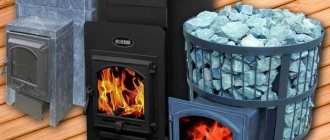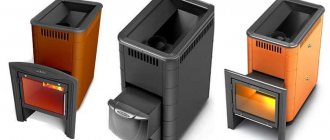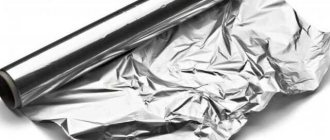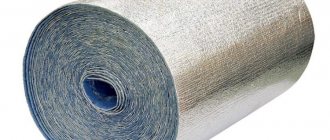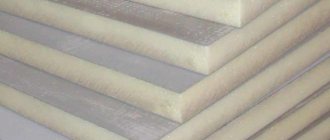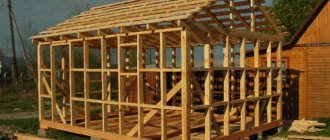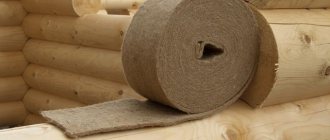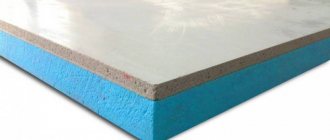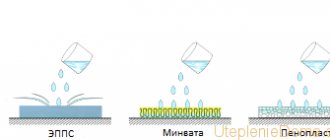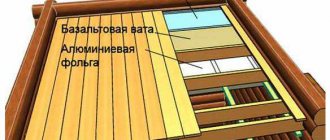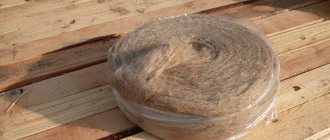Characteristics of insulation with foil
Let's consider the main advantages of insulation for a bath with foil:
- High resistance to temperature changes. This thermal insulator is often used for areas such as steam rooms, where the air temperature can rise to 150 degrees Celsius.
- Resistant to reflection and no water absorption. Foil insulation can be used to insulate any surface, even the floor.
- High performance in vapor barrier, waterproofing, thermal insulation. Due to its metallized coating, reflective thermal insulation is used for insulation of both residential and industrial buildings.
- Simple and easy installation. To install this type of material, you do not need to hire specialists or use special equipment. The installation process takes little time and effort.
Along with the advantages of foil insulation for a bath, there are also disadvantages, and the main one is due to the fact that the foil layer is susceptible to corrosion . But a heat insulator with a metallized layer does not have such a disadvantage, so it can be safely used in the construction of baths and saunas.
But when working with this insulation, you need to be careful and comply with all requirements, otherwise the result may disappoint you.
Aluminum can heat up and then transfer heat to its back surface, and then to the street. Therefore, in order for the insulation to perform its main function, it is necessary to ensure that the aluminum coating of the heat insulator does not overheat.
The way out of this situation would be to install an air gap on the inside of the room. The gap prevents the aluminum from overheating from direct heat transfer, and infrared rays will be reflected from the foil and back into the room.
Areas of use
Foil insulation has gained popularity in modern construction, and today it is often used to create effective vapor barrier and thermal insulation of baths and saunas, as well as to improve sound insulation performance for industrial premises.
It is especially often used for flooring, and has also proven itself to be excellent in the construction of multi-story buildings as an easy-to-use thermal insulation material.
Types of insulation with foil
The modern building materials market offers a choice of several types of insulation for baths and saunas with foil:
- simple rolled foil;
- foil paper or fabric;
- foil insulation (expanded polystyrene or polyethylene foam, glass or mineral wool).
Plain Roll Foil
Modern manufacturers of thermal insulation materials produce a huge variety of rolled foil, which differs in the width of the roll itself and the thickness of the foil. For baths and saunas, foil with a thickness of 30–300 microns is perfect, and the width does not matter, you can choose any one.
Foil paper or fabric
Insulation based on kraft paper is good from the point of view of ease of use and practicality. One side of this paper is covered with foil. The advantage of such an insulator is that it is resistant to high air temperatures, and also eliminates the possibility of dampness and mold, and copes well with its main responsibilities - retaining heat.
Foil insulation
Foamed polystyrene foam is covered with foil. The advantage of using this type of material is ease of installation , the ability to heat the room up to 150–160 degrees Celsius. For an example of mineral wool, you can consider foil-coated basalt wool, which is also produced in rolls and has fire-fighting and heat-insulating characteristics.
Insulating foil boards are another option for retaining heat in a bathhouse or sauna. They are manually coated with a thin layer of aluminum. This foil is perfect for baths and saunas. It is easily mounted on walls and attached to the ceiling. Another advantage of this material is that the foil will hide all hard-to-reach places in the bathhouse.
Insulation materials
244 votes
+
Vote for!
—
Vote against!
Modern production technologies make it possible to produce thermal insulation materials of a wide variety of types and structures. Of course, the use of each is determined by a number of requirements both for the environment of the future location and for the methods of installation and operation. Loyal pricing policy provides the opportunity to purchase heat insulators for everyone, regardless of their financial solvency. This article will talk about foil insulation for a bathhouse.
The importance of foil insulation in a bathhouse
- The bathhouse belongs to the category of structures where a certain level of humidity is assumed to be constantly present. This, in turn, limits the choice of not only building materials, but also insulation. Experts strongly recommend using thermal insulation material with foil or metallized film, which is based on polyethylene foam.
- Excellent performance characteristics provide the opportunity to create a kind of thermos indoors. Thanks to the reflective effect, all the heat is retained in the room without passing through existing cracks in the walls.
- Fastening slabs of foil insulation for walls allows you to hide existing imperfections on surfaces. It can be not only walls, but also the floor, and even the ceiling. Since the design features during the construction of a bathhouse provide for the presence of hard-to-reach places, the installation of this type of heat insulator will come in very handy.
- It would seem that the bathhouse construction project should already provide for all the nuances that allow maximum heat retention in the room. However, insulation with foil material has its advantages compared to analogues.
- As a rule, a bathhouse is a stationary single structure made using wooden beams. If the building is not properly insulated, it can take quite a lot of time and energy to warm it up. It is necessary to maintain optimal temperature conditions in the Priora. And this can waste a lot of energy. At the same time, there is a certain pattern - the higher the air temperature in the room, the greater the amount of heat evaporates through cracks and cracks formed as a result of poorly performed wall finishing work or natural aging and cracking of the material under the influence of constant changes in air temperature.
- Even if the bathhouse is a continuation of a residential building, then this method of insulation should not be neglected. After all, penetrating vapors can negatively affect other materials from which the structure is constructed. This, in turn, can cause rotting of individual elements and partial destruction of the surface, as well as contribute to the proliferation of various fungi and microorganisms. As a result, the decorative finish in the room may suffer.
- By improving the operating conditions of the bathhouse, you can thereby extend the overall service life. The presence of a vapor barrier will allow warm, humid air to condense exactly where it is needed.
- There are many opinions about what exactly needs to be insulated in a bathhouse. Some believe that warm air rises and the foil layer of material should be attached to the ceiling. Others believe that almost everything needs to be insulated.
- In order to prevent heat loss from the air, it is important to place insulation on all available surfaces in the room. However, do not forget to leave a gap, the dimensions of which can vary within 15-25 mm between the treated surface and the foil material.
Selection of foil material
Insulation with foil is available for sale in a wide range:
- foil roll insulation – has a fairly large roll width spread. The thickness of the foil can vary within 30-300 microns, which allows the material to be used in these conditions. You can buy insulation with foil in the price range from 20 to 200 rubles/m2, depending on the thickness of the material (2-40mm);
- paper or fabric base with a foil layer applied , an excellent insulation option that is resistant to air temperatures above 300 C. By retaining heat inside the room, the likelihood of the formation of traces of mold and the smell of dampness is eliminated;
- foil basalt insulation has the property of fire resistance (fireproof), which allows you to raise the temperature to a limit of 150-160 0 C.
Of course, each type has its own characteristics not only in terms of fasteners, but also operational characteristics. At the same time, the possibility of use in certain conditions is regulated by the manufacturer. The thickness of the foil insulation does not matter. It is important what kind of base structure it has.
- The formation of pricing is influenced by the thickness of the heat insulator, so the price of insulation with basalt-based foil is 800-1200 rubles/roll.
- This indicates that this material is available to almost all segments of the population for insulating not only a bathhouse, but also, for example, a balcony.
- The wide range of insulation options can be the main reason for the difficulty of choosing. Someone, relying solely on their own intuition, buys foil material. Others carefully study the characteristics, listen to the opinions of friends or specialists. The main thing is that both of them implement the only correct solution, which allows you to purchase high-quality insulation. Visually assessing the amount of work, it is important to take the exact dimensions of the room where thermal insulation is supposed to be carried out. This will allow you to purchase the required amount of material with maximum savings.
Rules for choosing insulation for a sauna with foil
- Each manufacturer adheres to its own nuances of manufacturing heat-insulating materials. However, in general, the production technology is the same for all, which allows us to assert the high quality of the products. The approximate value of the heat transfer resistance must be indicated on the packaging.
- When choosing a material for insulating a bath, you must carefully study the expected operating conditions. In addition, the range range is indicated, the thermal conductivity coefficient in which may vary, this may be evidence that this type of material is of low quality, since this value in this case indicates instability of characteristics. Experts say that based on the results of numerous experiments, the following pattern was established: the lower the thermal conductivity coefficient, the better the material will retain heat indoors.
- I would like to focus special attention on the information that is written on the labels. As a rule, manufacturers indicate approximate data regarding the operating conditions of the heat insulator. You should be extremely careful, since the resistance values are not indicated for a specific material, but its characteristics under the overall dimensions of a specific structure where it was used during testing.
- Many building materials that have an organic base emit toxic substances when heated to high temperatures, which is simply unacceptable, given that people relax and restore their health in a bathhouse or sauna. Inhaling toxic fumes for a long time can cause irreparable damage to health.
- Self-adhesive insulation with foil can simply melt when exposed to heat. Therefore, you should choose heat insulators with a minimum flammability rating. Fire safety comes first.
Main characteristics of thermal insulation material with foil
The undeniable advantages of using this type of insulation in a steam room include the following factors:
- high resistance to temperature changes (from 00C to +1500C);
- thanks to the mirror surface, thermal air flows are reflected;
- excellent indicator of water resistance, which expands the range of use of foil insulation (walls, ceiling, floor);
- has the properties of heat, hydro and vapor barrier. This indicates that the material can be used for insulation of any real estate, regardless of its further use (residential, industrial);
- ease of installation makes it possible to carry out all fastening work with your own hands without involving outside help.
Insulation with foil application
- Unlike other heat insulators, foil insulation is a priority material in construction and is popular when carrying out repair work in bathhouses and saunas. In addition to achieving a high rate of insulation of steam and heat indoors, there is also excellent sound insulation of individual rooms. This is important if both production premises and leisure rooms are located in the same building.
- Quite often, this material is used to insulate floors in multi-story buildings, where concrete slabs serve as floors. In addition, when laying communication systems, many construction teams use this insulation to eliminate the possibility of heat loss, even if the pipes are located deep underground. In places where ground freezing has been recorded, the foil material will prevent frost from capturing, for example, water.
Features of installation of foil insulation
Before proceeding with the installation of insulation with foil, it is necessary to carry out a number of measures, namely:
- treat the surface of the walls with a special product that will prevent the formation of mold and dampness;
- wooden planks should be installed at certain intervals around the entire perimeter of the room;
- Insulation is attached to this frame. It doesn’t matter at all what type it has – rolled or tiled;
- the joints are subsequently taped with special tape, which prevents moisture from getting under the insulation layer;
- the foil material must be covered with clapboard. However, you need to leave a small gap to avoid contact between the heated lining and the foil. The mirror surface will fully reflect the incoming hot air flows;
- It is not recommended to use foil insulation for the floor in a bathhouse, since the floor system involves a concrete screed on top of which a wooden flooring is mounted;
- in addition to insulating the walls, ceiling and floor, it is also important to insulate the entrance doors;
- External walls should be insulated with special care than interior walls.
- To fasten the foil material in the bathhouse, you will need a certain list of tools and construction supplies:
- planks of a certain size, made of wood and pre-treated with special means that protect the material from moisture;
- in fact, the thermal insulation material itself;
- construction stapler or regular nails;
- special tape (aluminum or vapor-tight) for masking insulation joints.
Having studied the proposed material and purchased all the necessary building materials, you can safely begin insulating both the entire bathhouse building and individual rooms. If any questions arise during the process of fastening the foil material, then having a certain amount of knowledge, you can solve all the problems without any problems. If you are not confident in your own abilities, you can use the services of qualified specialists who will fully or partially complete the task assigned to them.
Features of installing foil insulation
- This insulation with foil is installed directly on the wall and ceiling of the bath room with the foil side facing the room. If there is a need to insulate the entrance door of a bathhouse or sauna, then you can also use foil insulation for this.
- Installation of thermal insulation, waterproofing and vapor barrier of the walls of the bath room and sauna is carried out using a construction stapler or small nails; the seams must be properly taped with aluminum tape . To prevent moisture from accumulating at the junction of the wall and floor, it is necessary to make a small hole in the material.
- A wooden sheathing is mounted on the aluminum side of the heat-insulating material, onto which the eurolining will be attached.
It is also worth emphasizing that the main insulation of the walls of bathhouses and saunas traditionally occurs on the street side.
In order to reduce heat loss in the bathhouse, it is necessary to insulate the floor.
When insulating the floor of a bathhouse or sauna, you can use sand, thermal insulation materials and screed. This is a rather complicated process, so it is better to entrust it to a specialist .
Foil insulation for baths and saunas: environmentally friendly, does not get wet, does not rot
In most Russian developers' plans for developing a suburban area, the bathhouse is listed, if not number one, then at least number two. This is understandable. Is there anything better for recovery and recuperation than a good steam room? And the main quality of a good steam room is the ability to keep warm for a long time without loss.
Today, in addition to traditional log baths, bathhouses are built from laminated veneer lumber, concrete, brick, wood concrete, expanded clay and aerated concrete blocks. Whatever of these materials the building is made of, it needs reliable thermal insulation. This allows you to reduce fuel consumption, since the air in the steam room will warm up faster and maintain the desired temperature for a long time; maintain heat in the dressing room and wash room, the cooling of which can cause great discomfort, and also avoid heavy condensation on surfaces, which slowly but surely destroys the lining.
Considering the extreme operating conditions, the choice of insulation for a bath should be approached with the utmost seriousness. It must be resistant to moisture and temperature changes, tolerate prolonged exposure to heat, not be damaged by rot and mold, and not release harmful substances into the air.
As you know, hot air collects at the top of the steam room, so insulating the walls and ceiling here requires special care. Of course, floors also need to be insulated, but of the total heat loss they account for only 7–8%, while leaks through the ceiling can be up to 70%, and through walls, respectively, about 20%.
Most often, for the purpose of thermal insulation of steam and washing rooms in baths and saunas, rolled or slab mineral wool, extruded polystyrene foam (EPS) and polyurethane foam (PPU) are used. To enhance the thermal insulation effect of the slabs, a layer of aluminum foil is placed on top of them, which reflects up to 97% of infrared radiation, preventing it from being spent on heating the enclosing structures and preventing heat from escaping from the room. We can say that the foil turns the interior of the bathhouse into a kind of thermos. In addition, it is impermeable to water vapor, and therefore eliminates the need to use a vapor barrier film or membrane in the wall and roofing “pie.” Foil is resistant to corrosion and environmentally friendly, but it has a significant drawback - it is difficult to work with: it is a very thin material (50-100 microns), easily wrinkled and not tensile strength.
Structure of LOGICPIR foil insulation
The optimal combination of thermal insulation and reflective coating is the innovative LOGICPIR foil insulation from the TECHNONICOL company. It is created on the basis of PIR building polymer, which is a modified polyurethane foam with more stable internal bonds. The material has a closed-cell structure of increased rigidity and a double-sided coating of foil or laminated aluminum, applied by laminating (pressing) - it is this structure that determines the high physical, mechanical and operational characteristics of the insulation, as well as the stability of its properties.
LOGICPIR thermal insulation is characterized by a low thermal conductivity coefficient - 0.021 W/(m‧K), low density, compressive strength of at least 100 kPa, minimal water absorption - no more than 1% by volume. The material has high fire resistance (chars and fades), is not subject to destruction under the influence of chemical and biological factors and has a wide range of operating temperatures: from –65 to +120⁰С. This is an environmentally friendly insulation that does not emit harmful substances under any operating conditions (which is confirmed by the conclusion of the Institute of Solution Chemistry of the Russian Academy of Sciences and sanitary and hygienic certificates), and also retains its effectiveness and original geometric parameters for more than 50 years.
LOGICPIR is produced in the format of slabs with straight or L-shaped edges on all four sides, which serve to tightly join the products to each other and form a virtually monolithic warm contour without cold bridges. The length and width of the slabs with straight ends is 1200 × 600 mm, with an L-edge - 1190 × 590 mm; thickness - 20, 30, 40 and 50 mm; the weight of a 20 mm slab is about 50 g. For example, the price of LOGICPIR Bath insulation 1200 × 600 × 50 mm is 526 rubles/m², LOGICPIR Bath L 1190 × 590 × 30 mm is 405 rubles/m².
The TECHNONICOL LOGICPIR line includes highly effective thermal insulation materials specifically designed for insulation of various types of pitched roofs, balconies, heated floors, enclosing structures of baths and saunas
Scheme of insulation of walls and ceilings in a bathhouse
For insulation of walls and ceilings in steam rooms, the manufacturer offers a comprehensive solution TN-WALL Bathhouse PIR, which provides for the creation of a continuous thermal insulation circuit. Unlike the classic insulation installation scheme, this system does not require a pre-assembled wall frame-lathing: LOGICPIR foil slabs are laid in a continuous layer on a brick, concrete or wooden base (and on the roof - directly on top of the rafters) and a counter-lattice made of 20 × 30 bars is installed mm for forming an air gap and fastening the sheathing material. The joints of the slabs are glued with aluminum tape - a reinforced self-adhesive tape 50 mm wide, which allows you to create an absolutely sealed vapor and heat insulation circuit on the surfaces of the walls and ceiling. It is devoid of permeable seams, and, therefore, building structures are reliably protected from moisture, and thanks to the reflective properties of the foil, it provides maximum heat conservation.
